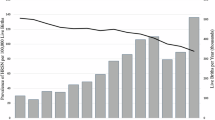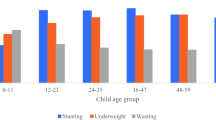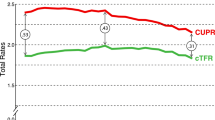Abstract
Objective
This study evaluates differences in child healthcare utilization by maternal fertility status in the first four years of life.
Study design
The retrospective cohort evaluated Massachusetts (MA) live born infants using data linked from clinical assisted reproductive technology (ART) data, birth certificates, and hospital discharge records. Hospital records of infants born 2004–2017 to mothers of fertile (no infertility treatments or indicators of infertility), unassisted subfertile (UF, indicators of infertility but no fertility treatment), medically assisted reproduction (MAR, non-ART assistance with reproduction) and ART treatment were studied. Adjusted relative risk (aRR) was calculated using multivariable log binomial regression models.
Results
We included 339,426 singleton live-born infants discharged from birth hospitalization. Compared to children born to fertile mothers, those born to UF, MAR and ART-treated mothers were more likely to have hospital-based care (aRR 1.06–1.21) in their first 4 years.
Conclusions
Maternal subfertility with and without treatment was associated with small increases in child healthcare utilization.
This is a preview of subscription content, access via your institution
Access options
Subscribe to this journal
Receive 12 print issues and online access
$259.00 per year
only $21.58 per issue
Buy this article
- Purchase on SpringerLink
- Instant access to full article PDF
Prices may be subject to local taxes which are calculated during checkout

Similar content being viewed by others
References
Adamson GD, de Mouzon J, Chambers GM, Zegers-Hochschild F, Mansour R, Ishihara O. et al. International Committee for Monitoring Assisted Reproductive Technology: world report on assisted reproductive technology, 2011. Fertil Steril. 2018;110:1067–79. https://doi.org/10.1016/j.fertnstert.2018.06.039.
Hansen M, Kurinczuk JJ, Bower C, Webb S. The risk of major birth defects after intracytoplasmic sperm injection and in vitro fertilization. N. Engl J Med. 2002;346:725–30.
Helmerhorst FM, Perquin DAM, Donker D, Keirse JNC. Perinatal outcome of singletons and twins after assisted conception: a systematic review of controlled studies. BMJ. 2004;328:261–6.
Hansen M, Bower C, Milne E, de Klerk N, Kurinczuk JJ. Assisted reproductive technologies and the risk of birth defects—a systematic review. Hum Reprod. 2005;20:328–38.
Reefhuis J, Honein MA, Schieve LA, Correa A, Hobbs CA, Rasmussen SA.the National Birth Defects Prevention Study. Assisted reproductive technology and major structural birth defects in the United States. Hum Reprod. 2009;24:360–6.
El-Chaar D, Yang Q, Gao J, Bottomley J, Leader A, Wen SW, et al. Risk of birth defects increased in pregnancies conceived by assisted human reproduction. Fertil Steril. 2009;92:1557–61.
Schieve LA, Ferre C, Peterson HB, Macaluso M, Reynolds MA, Wright VC. Perinatal outcome among singleton infants conceived through assisted reproductive technology in the United States. Obstet Gynecol. 2004;103:1144–11538.
Sutcliffe AG, Ludwig M. Outcome of assisted reproduction. Lancet. 2007;370:351–9.
Henningsen AK, Pinborg A, Lidegaard O, Vestergaard C, Forman JL, Andersen AN. Perinatal outcome of singleton siblings born after assisted reproductive technology and spontaneous conception: Danish national sibling cohort study. Fertil Steril. 2011;95:959–63.
Pinborg A, Wennerholm UB, Romundstad LB, Loft A, Aittomaki K, Soderstrom-Antilla V, et al. Why do singletons conceived after assisted reproduction technology have adverse perinatal outcome? Systematic review and meta-analysis. Hum Reprod Update. 2013;19:87–104.
Dunetz GL, Holzman C, McKane P, Li C, Boulet SL, Todem D, et al. Assisted reproductive technology and the risk of preterm birth among primiparas. Fertil Steril. 2015;103:974–9. https://doi.org/10.1016/j.fertnstert.2015.01.015.
Raju TNK, Buist AS, Blaisdell CJ, Moxey-Mims M, Saigal S. Adults born preterm: a review of general health and system-specific outcomes. Acta Paediatr. 2017;106:1409–37. https://doi.org/10.1111/apa.13880.
Declercq E, Luke B, Belanoff C, Cabral H, Diop H, Gopal D, et al. Perinatal outcomes associated with assisted reproductive technology: the Massachusetts outcomes study of assisted reproductive technologies (MOSART). Fertil Steril. 2015;103:888–95.
Luke B, Gopal D, Cabral H, Stern JE, Diop H. Pregnancy, birth, and infant outcomes by maternal fertility status: the Massachusetts outcomes study of assisted reproductive technology. AM J Obstet Gynecol. 2017;217:e1–14.
Chen M, Heilbronn LK. The health outcomes of human offspring conceived by assisted reproductive technologies (ART). J Dev Orig Health Dis. 2017;8:388–402.
Bergh C, Wennerholm UB. Long-term health of children conceived after assisted reproductive technology. J Med Sci. 2020:125. https://doi.org/10.1080/03009734.2020.1729904.
Pinborg A, Loft A, Schmidt L, Andersen AN. Morbidity in a Danish National cohort of 472 IVF/ICSI twins, 1132 non-IVF/ICSI twins and 634 IVF/ICSI singletons: health-related and social implications for the children and their families. Hum Reprod. 2003;18:1234–43.
Catford SR, McLachlan RI, O’Bryan MK, Halliday JL. Long-term follow-up of intra-cytoplasmic sperm injection conceived offspring compared with in vitro fertilization-conceived offspring: a systematic review of health outcomes beyond the neonatal period. Andrology. 2017;5:610–21.
Zandstra H, Brentjens LBPM, Spauwen B, Touwslager RNH, Bons JAP, Mulder AL, et al. Association of culture medium with growth, weight and cardiovascular development of IVF children at the age of 9 years. Hum Reprod. 2018;33:1645–56.
Heijligers M, Peeters A, van Montfoort A, Nijsten J, Janssen E, Gunnewiek FK, et al. Growth, health, and motor development of 5-year-old children born after preimplantation genetic diagnosis. Fertil Steril. 2019;111:1151–8.
Hwang SS, Dukhovny D, Gopal D, Cabral H, Missmer SA, Diop H, et al. Health of infants following ART-treated, subfertile and fertile deliveries in Massachusetts. Pediatrics. 2018;142:e20174069. https://doi.org/10.1542/peds.2017-4069.
Kotelchuck M, Hoang L, Stern JE, Diop H, Belanoff C, Declercq E. The MOSART database: linking the SART CORS clinical database to the population-based Massachusetts PELL reproductive public health data system. Matern Child Health J. 2014;18:2167–78.
Declercq ER, Belanoff C, Diop H, Gopal D, Hornstein MD, Kotelchuk M, et al. Identifying women with indicators of subfertility in a statewide population database: operationalizing the missing link in assisted reproductive technology research. Fertil Steril. 2014;101:463–71.
Zegers-Hochschild F, Adamson GD, Dyer S, Racowsky C, de Mouzon J, Sokol R, et al. The international glossary on infertility and fertility care, 2017. Fertil Steril. 2017;108:393–406.
Dukhovny D, Hwang SS, Gopal D, Cabral H, Missmer S, Diop H, et al. Length of stay and cost of birth hospitalization: effects of subfertility and ART. JPerinatol. 2018. https://doi.org/10.1038/s41372-018-0205-9.
Stern JE, Liu CL, Cabral H, Gopal D, Harvey E, Missmer SA, et al. Hospitalization before and after delivery in fertile, subfertile, and ART-treated women. JARG. 2019;36:1989–97. https://doi.org/10.1007/s10815-019-01562-2.
Ceelen M, van Weissenbruch MM, Prein J, Smit JJ, Vermeiden JPW, Spreeuwenberg M. et al. Growth during infancy and early childhood in relation to blood pressure and body fat measures at age 8–18 years of IVF children and spontaneously conceived controls born to subfertile parents. Hum Reprod. 2009;24:2788–95. https://academic.oup.com/humrep/article/24/11/2788/627120.
Hart R, Norman RJ. The longer-term health outcomes for children born as a result of IVF treatment: part I–General health outcomes. Hum Reprod Update. 2013;19:232–43. https://academic.oup.com/humupd/article/19/3/232/727781
Dovey S, Weitzman M, Fryer G, Green, Lawn B, Lanier D, et al. The ecology of medical care for children in the United States. Pediatrics. 2003;111:1024–9. https://pediatrics.aappublications.org/content/111/5/1024.
Simpson L, Owens PL, Zodet MW, Chevarley FM, Dougherty D, Elixhauser A, et al. Health care for children and youth in the United States: annual report on patterns of coverage, utilization, quality, and expenditures by income. Ambul Pediatr. 2005;5:6–44. https://doi.org/10.1367/A04-119R.1.
Srebnik N, Miron-Shatz T, Rolison JJ, Hanoch Y, Tsafrir A. Physician recommendation for invasive prenatal testing: the case of the’precious baby. Human Reprod. 2013;28:3007–11.
Bacal V, Russo M, Fell DB, Shapiro H, Walker M, Gaudet LM. A systematic review of database validation studies among fertility populations. Hum Reprod Open. 2019; 1–14. https://doi.org/10.1093/hropen/hoz010.
Acknowledgements
Society for Assisted Reproductive Technology (SART) wishes to thank all of its members for providing clinical information to the SART CORS database for use by patients and researchers. Without the efforts of SART members, this research would not have been possible.
Funding
This study was supported by a grant from the National Institutes of Health RO1HD67270.
Author information
Authors and Affiliations
Corresponding author
Ethics declarations
Conflict of interest
The authors declare no competing interests.
Additional information
Publisher’s note Springer Nature remains neutral with regard to jurisdictional claims in published maps and institutional affiliations.
Rights and permissions
About this article
Cite this article
Dukhovny, D., Hwang, S.S., Gopal, D. et al. Association of maternal fertility status and receipt of fertility treatment with healthcare utilization in infants up to age four. J Perinatol 41, 2408–2416 (2021). https://doi.org/10.1038/s41372-021-01003-y
Received:
Revised:
Accepted:
Published:
Issue date:
DOI: https://doi.org/10.1038/s41372-021-01003-y



